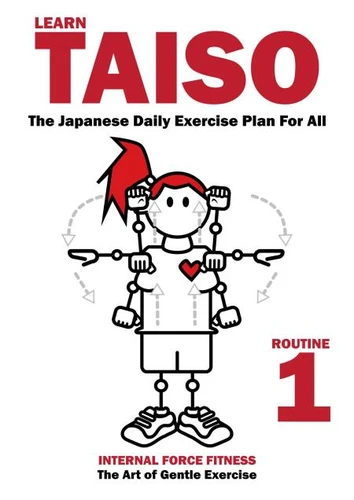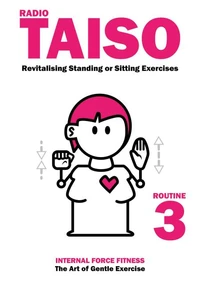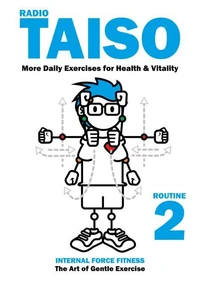Learn Taiso: The Japanese Daily Exercise Plan For All - English Language Edition. Radio Taiso, #1
Par :Formats :
Disponible dans votre compte client Decitre ou Furet du Nord dès validation de votre commande. Le format ePub est :
- Compatible avec une lecture sur My Vivlio (smartphone, tablette, ordinateur)
- Compatible avec une lecture sur liseuses Vivlio
- Pour les liseuses autres que Vivlio, vous devez utiliser le logiciel Adobe Digital Edition. Non compatible avec la lecture sur les liseuses Kindle, Remarkable et Sony
 , qui est-ce ?
, qui est-ce ?Notre partenaire de plateforme de lecture numérique où vous retrouverez l'ensemble de vos ebooks gratuitement
Pour en savoir plus sur nos ebooks, consultez notre aide en ligne ici
- FormatePub
- ISBN978-1-393-52655-1
- EAN9781393526551
- Date de parution07/06/2020
- Protection num.pas de protection
- Infos supplémentairesepub
- ÉditeurRelay Publishing
Résumé
FITNESS, health, longevity, well-being, and mental health all benefit from Tai-So, the famous system of Japanese body conditioning exercises for all ages and abilities. Sometimes described as warm-up calisthenics, this just means we are only using our body weight as resistance in order to exercise fully. What is TAI-SO?For simplicity let's translate it as Tai = Body, and So = Conditioning. It's a neat variant of Tai Chi, which is Tai = Body, and Chi = Energy.
Tai-So routines are a series of gentle, yet invigorating body conditioning exercises designed to warm the body up, raise energy levels and encourage overall good health. The 'radio' part, when described as 'Radio' (or Rajio) Tai-So, comes simply from the fact the instructions and tempo for performing these exercises are broadcast on the radio in Japan. Whether you are looking to banish early morning aches with gentle stretches to loosen your joints, or you just want something to energise you during the working day, then a Tai-So routine could be just the exercise program for you!Exercises For Health And VigourExercise routines that can be performed by any age, fitness and gender for EQUAL benefit are hard to come by.
The first Tai-So series of exercises however is one such routine. Performed with a nice light rhythm, the aim of these exercises is to allow you to move more easily as you develop well-balanced muscles and nice supple joints throughout your entire body. This isn't bodybuilding, this is building a better body!History Of Radio Tai-SoJapanese radio calisthenics emerged in the 1920's and have been performed in schools and workplaces ever since for building HEALTH.
The program is also used to build a sense of COMMUNITY in neighbourhoods, where the exercises are performed all together by young and old alike. What Are Radio Calisthenics?In a nutshell, they are simply exercises set to a musical radio accompaniment. Every day an instructor plays special music to guide the listeners through the movements. They are workouts that practically every Japanese person knows by heart, having learned some variation from a very young age.
They are an extremely popular form of exercise in Japan and it is estimated up to 10 MILLION people practice them regularly. They are becoming even MORE popular (including globally) as their many health benefits are championed by medical experts. What Are The Fitness Benefits Of These Exercises?The primary benefit of these exercises is that they put joints through their full range of possible motion.
In daily life joint movements usually fall well short of their full range, so muscles can gradually shrink. Simply by moving your body through a FULL range of motion every day you can see how your body will keep working better for longer. The exercises can also improve agility and posture, which can in turn help with simple things like getting up from a chair or getting down onto the ground. Furthermore, performing gentle exercises such as these in the morning will get the blood flowing around your body, which in turn will energise you, loosen your joints and get rid of accumulated stiffness.
Does This Mean All Japanese People Are Fit?At the time of writing, it is estimated under 4% of Japanese people are considered 'obese', and while there are of course many factors at play here, the fact so many Japanese take part in a daily exercise routine surely must play a part. Also, a great many Japanese people remain 'fitter' for longer, i.e. keep functionally active well into old age. Again, a lifetime of performing stretching and movement-based exercises is a likely piece of the puzzle.
Tai-So routines are a series of gentle, yet invigorating body conditioning exercises designed to warm the body up, raise energy levels and encourage overall good health. The 'radio' part, when described as 'Radio' (or Rajio) Tai-So, comes simply from the fact the instructions and tempo for performing these exercises are broadcast on the radio in Japan. Whether you are looking to banish early morning aches with gentle stretches to loosen your joints, or you just want something to energise you during the working day, then a Tai-So routine could be just the exercise program for you!Exercises For Health And VigourExercise routines that can be performed by any age, fitness and gender for EQUAL benefit are hard to come by.
The first Tai-So series of exercises however is one such routine. Performed with a nice light rhythm, the aim of these exercises is to allow you to move more easily as you develop well-balanced muscles and nice supple joints throughout your entire body. This isn't bodybuilding, this is building a better body!History Of Radio Tai-SoJapanese radio calisthenics emerged in the 1920's and have been performed in schools and workplaces ever since for building HEALTH.
The program is also used to build a sense of COMMUNITY in neighbourhoods, where the exercises are performed all together by young and old alike. What Are Radio Calisthenics?In a nutshell, they are simply exercises set to a musical radio accompaniment. Every day an instructor plays special music to guide the listeners through the movements. They are workouts that practically every Japanese person knows by heart, having learned some variation from a very young age.
They are an extremely popular form of exercise in Japan and it is estimated up to 10 MILLION people practice them regularly. They are becoming even MORE popular (including globally) as their many health benefits are championed by medical experts. What Are The Fitness Benefits Of These Exercises?The primary benefit of these exercises is that they put joints through their full range of possible motion.
In daily life joint movements usually fall well short of their full range, so muscles can gradually shrink. Simply by moving your body through a FULL range of motion every day you can see how your body will keep working better for longer. The exercises can also improve agility and posture, which can in turn help with simple things like getting up from a chair or getting down onto the ground. Furthermore, performing gentle exercises such as these in the morning will get the blood flowing around your body, which in turn will energise you, loosen your joints and get rid of accumulated stiffness.
Does This Mean All Japanese People Are Fit?At the time of writing, it is estimated under 4% of Japanese people are considered 'obese', and while there are of course many factors at play here, the fact so many Japanese take part in a daily exercise routine surely must play a part. Also, a great many Japanese people remain 'fitter' for longer, i.e. keep functionally active well into old age. Again, a lifetime of performing stretching and movement-based exercises is a likely piece of the puzzle.
FITNESS, health, longevity, well-being, and mental health all benefit from Tai-So, the famous system of Japanese body conditioning exercises for all ages and abilities. Sometimes described as warm-up calisthenics, this just means we are only using our body weight as resistance in order to exercise fully. What is TAI-SO?For simplicity let's translate it as Tai = Body, and So = Conditioning. It's a neat variant of Tai Chi, which is Tai = Body, and Chi = Energy.
Tai-So routines are a series of gentle, yet invigorating body conditioning exercises designed to warm the body up, raise energy levels and encourage overall good health. The 'radio' part, when described as 'Radio' (or Rajio) Tai-So, comes simply from the fact the instructions and tempo for performing these exercises are broadcast on the radio in Japan. Whether you are looking to banish early morning aches with gentle stretches to loosen your joints, or you just want something to energise you during the working day, then a Tai-So routine could be just the exercise program for you!Exercises For Health And VigourExercise routines that can be performed by any age, fitness and gender for EQUAL benefit are hard to come by.
The first Tai-So series of exercises however is one such routine. Performed with a nice light rhythm, the aim of these exercises is to allow you to move more easily as you develop well-balanced muscles and nice supple joints throughout your entire body. This isn't bodybuilding, this is building a better body!History Of Radio Tai-SoJapanese radio calisthenics emerged in the 1920's and have been performed in schools and workplaces ever since for building HEALTH.
The program is also used to build a sense of COMMUNITY in neighbourhoods, where the exercises are performed all together by young and old alike. What Are Radio Calisthenics?In a nutshell, they are simply exercises set to a musical radio accompaniment. Every day an instructor plays special music to guide the listeners through the movements. They are workouts that practically every Japanese person knows by heart, having learned some variation from a very young age.
They are an extremely popular form of exercise in Japan and it is estimated up to 10 MILLION people practice them regularly. They are becoming even MORE popular (including globally) as their many health benefits are championed by medical experts. What Are The Fitness Benefits Of These Exercises?The primary benefit of these exercises is that they put joints through their full range of possible motion.
In daily life joint movements usually fall well short of their full range, so muscles can gradually shrink. Simply by moving your body through a FULL range of motion every day you can see how your body will keep working better for longer. The exercises can also improve agility and posture, which can in turn help with simple things like getting up from a chair or getting down onto the ground. Furthermore, performing gentle exercises such as these in the morning will get the blood flowing around your body, which in turn will energise you, loosen your joints and get rid of accumulated stiffness.
Does This Mean All Japanese People Are Fit?At the time of writing, it is estimated under 4% of Japanese people are considered 'obese', and while there are of course many factors at play here, the fact so many Japanese take part in a daily exercise routine surely must play a part. Also, a great many Japanese people remain 'fitter' for longer, i.e. keep functionally active well into old age. Again, a lifetime of performing stretching and movement-based exercises is a likely piece of the puzzle.
Tai-So routines are a series of gentle, yet invigorating body conditioning exercises designed to warm the body up, raise energy levels and encourage overall good health. The 'radio' part, when described as 'Radio' (or Rajio) Tai-So, comes simply from the fact the instructions and tempo for performing these exercises are broadcast on the radio in Japan. Whether you are looking to banish early morning aches with gentle stretches to loosen your joints, or you just want something to energise you during the working day, then a Tai-So routine could be just the exercise program for you!Exercises For Health And VigourExercise routines that can be performed by any age, fitness and gender for EQUAL benefit are hard to come by.
The first Tai-So series of exercises however is one such routine. Performed with a nice light rhythm, the aim of these exercises is to allow you to move more easily as you develop well-balanced muscles and nice supple joints throughout your entire body. This isn't bodybuilding, this is building a better body!History Of Radio Tai-SoJapanese radio calisthenics emerged in the 1920's and have been performed in schools and workplaces ever since for building HEALTH.
The program is also used to build a sense of COMMUNITY in neighbourhoods, where the exercises are performed all together by young and old alike. What Are Radio Calisthenics?In a nutshell, they are simply exercises set to a musical radio accompaniment. Every day an instructor plays special music to guide the listeners through the movements. They are workouts that practically every Japanese person knows by heart, having learned some variation from a very young age.
They are an extremely popular form of exercise in Japan and it is estimated up to 10 MILLION people practice them regularly. They are becoming even MORE popular (including globally) as their many health benefits are championed by medical experts. What Are The Fitness Benefits Of These Exercises?The primary benefit of these exercises is that they put joints through their full range of possible motion.
In daily life joint movements usually fall well short of their full range, so muscles can gradually shrink. Simply by moving your body through a FULL range of motion every day you can see how your body will keep working better for longer. The exercises can also improve agility and posture, which can in turn help with simple things like getting up from a chair or getting down onto the ground. Furthermore, performing gentle exercises such as these in the morning will get the blood flowing around your body, which in turn will energise you, loosen your joints and get rid of accumulated stiffness.
Does This Mean All Japanese People Are Fit?At the time of writing, it is estimated under 4% of Japanese people are considered 'obese', and while there are of course many factors at play here, the fact so many Japanese take part in a daily exercise routine surely must play a part. Also, a great many Japanese people remain 'fitter' for longer, i.e. keep functionally active well into old age. Again, a lifetime of performing stretching and movement-based exercises is a likely piece of the puzzle.





